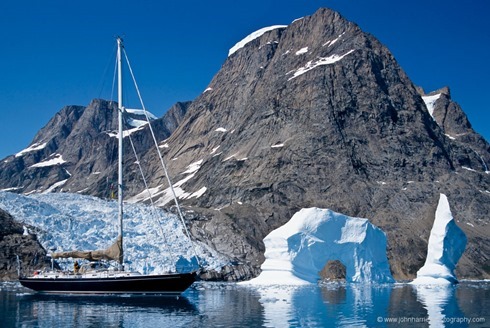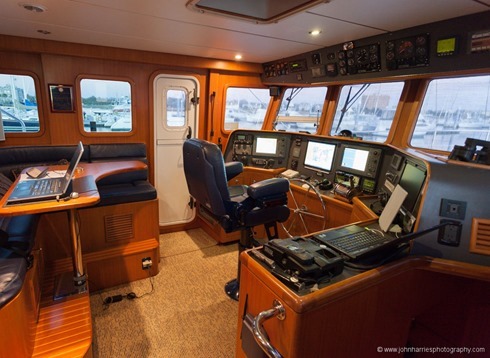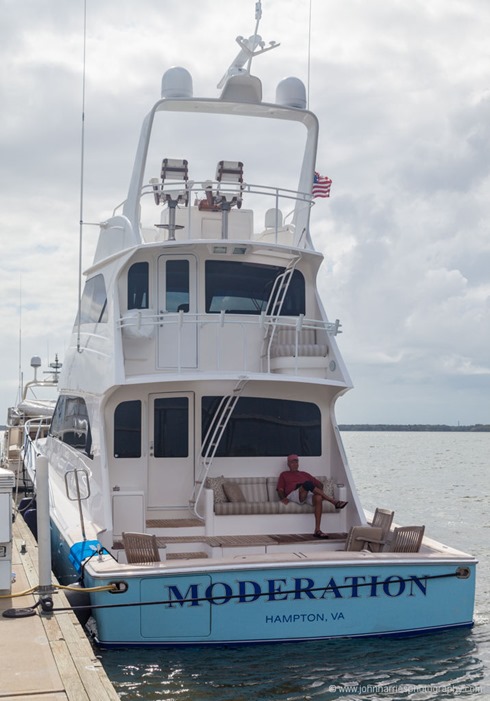http://www.morganscloud.com/2013/07/19/a-sailors-motorboat/?utm_source=feedburner&utm_medium=email&utm_campaign=Feed%3A+AttainableAdventureCruising+%28Attainable+Adventure+Cruising%29
I'm not going to argue with John about his numbers, but will say - my last 10,000 miles of real cruising numbers prove that our motor (Bruce Roberts designed sailboat hull) boat can save while keeping up with or actually passing John's MORGAN's CLOUD underway depending on the passage. HOW YOU PUT IT ALL TOGETHER AND OPERATE IT IS THE KEY TO GOOD ECONOMY.
Here is a re-posted copy for easy reading... enjoy - and think about subscribing - this is one of the best blogs on useful boating informations today.
BE SURE TO READ THE COMMENTS FROM REAL BOAT PEOPLE.
(5000 nm / 7.8kts = 641 hours x 3.4 gph = 2180 gallons x $6/gallon = $13,080.00)
A Sailor’s Motorboat
Phyllis and I own a better motorboat, for our purposes, than most motorboats. Let me explain why I say that and why it matters.
Morgan’s Cloud as a Motorboat
Let’s examine some real world numbers that I have compiled over 20 years of motoring close to 40% of the time in our 52,000 pound displacement McCurdy and Rhodes 56: (In the Arctic, the tendency is that it’s either blowing like hell, in which case you try to be snugged up somewhere, or there is no wind at all and you are motoring.)
- Low speed cruise at 6 knots burning just 1.1 US gallons (4.2 liters) an hour, yielding almost 6 miles to the US gallon.
- High speed cruise at 7.8 knots burning 2.4 gallons (9 liters) an hour, yielding 3.25 miles per gallon.
- All empty range of about 1700 miles at low speed cruise.
- All empty range of about 1000 miles at high speed cruise.
- Really good stabilization as long as there is even the tiniest amount of wind. Rolls her guts out with no wind, although we are quite used to that and it bothers us less than you might think.
- Sail assist that can halve the fuel burn in optimal conditions.
- Built-in get home power in case the main engine fails. For the motorboat people in the audience, we sailors call it a rig.
- Walk-in stand up engine room.
- Limit of positive stability of about 140 degrees, without taking deckhouses into account.
- Relatively long thin displacement hull that needs just 87 HP to reach 9.6 knots burning 4.6 gallons (17.5 liters) an hour (estimate from engine power curve).
A Trawler
Let’s compare that to a popular trawler yacht sold as ocean capable that is a bit shorter, although much heavier. These numbers are also real world taken from an account, by a very experienced (and honest) skipper, of a trans-Atlantic passage. (Note that, to be fair to the trawler, I have had to do some estimated adjustments for things like backing out generator use.):
- Low speed cruise around 6.5 knots burning about 3.5 gallons (13.2 liters) an hour, yielding 1.8 miles per gallon. (how about 2.3 gph)
- High speed cruise of around 7.8 knots burning about 6 gallons (22.7 liters) an hour or 1.3 miles per gallon—ouch! (how about 3.4 gph)
- All empty range of about 3000 miles at low speed cruise. (depends on tankage)
- All empty range of about 1900 miles at high speed cruise. (depends on tankage)
- Separate get-home wing engine. (other alternatives should be considered)
- Walk-in stand up engine room with even more room than Morgan’s Cloud.
- Substantially more accommodation space. Like about double, although not as usable as you might think because a lot of space gets wasted in short wide boats. (Plus a full sized washer and dryer, large shower and head - feels like home not RV camping.)
- Really nice wheelhouse for watch standing and watching the world go by in comfort. (Don't forget about standing outside on most sailboats taking your turn at the wheel - Arctic cold? Yabetcha!).
- Active stabilizers that work in all conditions (unless they fail) but increase fuel burn. (alternative 'fish' paravanes should be considered - no power required to use underway)
- Limit of positive stability of…well, the builder does not, at least that I can find, publish that, or, I suspect, wish to discuss it. I’m guessing between 70 and 90 degrees, and that assumes that the deck houses stay watertight. (Come on John - you said 'crossing oceans' quality)
- Needs 174 HP to reach 9.3 knots burning 9.5 gallons (36 liters) an hour (estimate from engine power curve).
For our needs, it’s a clear win for Morgan’s Cloud as a motorboat. She burns much less fuel and she is safer offshore, due to her stability. (How you use power is the key to economy - if you are in a hurry then a trawler is a poor choice.)
The motorboat wins on space, wheelhouse and range under power.
A Real Cruise
Let’s take a moment to quantify Morgan’s Cloud’s advantage over a typical year in which we tend to cover about 5000 miles. And let’s assume that the summer includes an Arctic trip, so we motor half of it and we really don’t like going slowly so we do that at high speed cruise.
A quick moment with the calculator yields 750 gallons of fuel, although experience would say closer to 500 due to sail assist, but we will forget that and go with 750 gallons over the year, at say an average of US$6.00 per gallon, which equals US$4500. Certainly a lot of money, but keep in mind that is all of our energy use: motion, heat, electricity, refrigeration, the works.
But now let’s assume the trawler yacht above comes on the cruise with us. They will burn up…$23,000, assuming they keep up with us at 7.8 knots. Way beyond anything that Phyllis and I could afford, even assuming that we were willing to be responsible for that kind of environmental footprint, which we are not.
By the way, it is not my intent here to beat trawler owners over the head with an environmental cudgel. Most of them do way fewer miles a year than Phyllis and I, and do them slower. In fact, I would guess that, if they live aboard full time, or just have a small shore-base, many of them have a way lower carbon footprint than the average North American family with a huge home (or maybe two) and two gas guzzling cars, who fly many times a year.
(Now don’t get me started on sports fishing boats that measure their fuel burn in gallons per mile. Moderation, my…)
A Better Idea
But suppose a smart designer looked at what a good sailboat like Morgan’s Cloud can do as a motorboat and learned from that. Suppose he or she kept the same 84 HP engine but changed some things:
- Removed most of the keel, because you don’t need much of one if you don’t have a mast—that would be good, because the wetted surface goes way down.
- Got rid of most of the 18,000 pounds of lead, for the same reason.
- Squared off the stern and got rid of the aft overhang, because motorboats don’t heel, so you don’t need a pointy stern to match the pointy bow (as long as you get the prismatic coefficient and water plane balance right).
- Got rid of some of the bow overhang.
- Added a wheelhouse.
Wow, we would get a boat that is even more fuel efficient than Morgan’s Cloud, because it (the motorboat) is 10-feet longer on the water line, 20,000 pounds lighter and has less wetted surface. And has about the same usable living space, because of the wheelhouse over the engine room.
(THIS IS A MAJOR POINT - STUDY THIS UNTIL YOU "GET IT".)
(THIS IS A MAJOR POINT - STUDY THIS UNTIL YOU "GET IT".)
Wait, our designer makes things even better. He or she replaces our flat bladed feathering propeller with an adjustable (Controllable Pitch) pitch propeller so that the engine’s torque can be matched to the propeller at all RPM settings.
How good would this be? Insanely good: (AT A VERY DEAR PRICE - PRICE A CP PROP - BUT CONSIDER THIS OVER THE LIFE OF THE VESSEL - ARE YOU A CRUISER OR MARINA BOATER? A 'CP' PROP WILL PAY FOR ITSELF.)
Low Speed
Low speed cruise could be as good as 6 knots at just 0.6 gallons (2.2 liters) an hour. That’s 10 miles to the gallon!
High Speed
High speed cruise could be 1.8 gallons (6.8 liters) an hour at 8 knots, maybe even less, for 4.4 miles to the gallon.
Panic Speed
Panic cruise could be…What, you have never heard of panic cruise? That’s the speed you want to do when it’s late November, you have been sitting in Newport for three weeks waiting for a weather window to go to Bermuda and a sliver of a window opens up on the back of a fast moving cold front. Panic cruise is a minimum of 10 knots, which gets you to Bermuda in just two and a half days, and this boat can deliver that at about 4 gallons an hour.
And that changes everything. You are sitting in the White Horse Pub hoisting a beer while everybody else is getting their butts handed to them by the next cold front.
And you know what? As Dave Gerr has been pointing out for years, even though you ran at panic cruise all the way, if there are four of you aboard, it cost you less to get to Bermuda than if you had flown. If you cut back to fast cruise (8 knots), increasing the transit time to just over three days (still faster than most sailboats), the cost is half that of flying.
Cheaper Than Sailing?
Now let’s go back and look at what happens if this motorboat accompanies Morgan’s Cloud on her typical 5000 miles a year of cruising and both boats do it at 7.8 knots. The motorboat owner spends about US$6521 over the year or about $2000, more than Phyllis and I do.
But, I hate to tell you fellow sailors, that increment is about a third to a half of what Morgan’s Cloud’s rig and sails cost to maintain over 5000 miles. Crank in the carbon footprint of making and maintaining sails and rig, and the environmental impact is about the same for the two boats, I would guess.
Now, before a small riot starts, I’m not saying we should all buy motorboats, or that Phyllis and I are going to do that, but it does behoove us to recognize reality and not stick our heads in the sand about what this sailing thing we are all addicted to really costs, particularly if you do it in places where you have to motor a lot of the time.
It’s Tragic
You know what the sad thing is? Designing a motorboat that can pull off these numbers and deliver the added safety conferred by “panic cruise” is not just possible, it’s pretty easy. And this guy, and this guy, even know exactly how to do it. In fact, I’m guessing most any competent naval architect can do it.
Like with the dearth of good offshore sailboats available to buy, the problem is this obsession the market has with short wide boats with huge interiors—beats me, I don’t get it either.
Of course, you can get one of Steve and Linda Dashew’s incredible boats, assuming you are, shall we say, financially fortunate and want a boat that is nearly three times larger than the one that I sketched out above.
What Are We Voyaging Sailors Going to Do?
But it seems that, other than that very expensive option, there simply has not been anything much around lately—Robert Beebe had this cracked years ago—that I would class as an efficient voyaging sailor’s offshore motorboat. And that’s a problem since we are all aging and many of us will one day need, or at least want, to make the transition to the dark side if we are going to keep voyaging.
But now there is a young designer that has not only drawn a boat to the specification above, but has put his money where his mouth is by selling his house to finance building a prototype. More on the boat in the next post.



1 comment:
the list of motor boats mentioned as its own strength and weaknesses. If ever your on a hunt for one visiting this motor boats for sale in the philippines might be one of the best places to buy a motor boat from.
Post a Comment
Enter your comment(s) here...